

|
| ČESKÁ REPUBLIKA | CZECH REPUBLIC |
| Vysočina | Highlands (Jihlava) region |
| Okres: Jihlava |
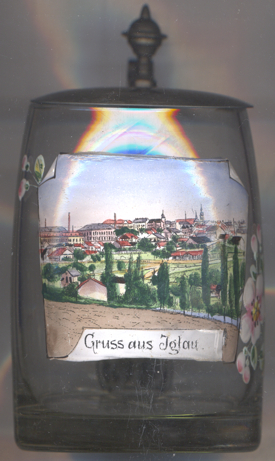
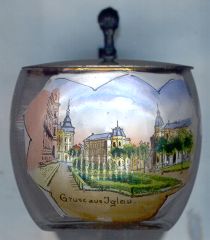 Jihlava (in German: Iglau) is situated at an elevation of 492 on the river Jihlava (Igel, Iglawa). During the times of
the Austro-Hungarian monarchy, the border between Bohemia and Moravia followed the headwaters of the river down until Jihlava,
which was located at the Moravian side of the border. Today, Jihlava has a population of about 50,000 and is the capital
of the Vysočina (Uplands) region of the Czech Republic.
Jihlava (in German: Iglau) is situated at an elevation of 492 on the river Jihlava (Igel, Iglawa). During the times of
the Austro-Hungarian monarchy, the border between Bohemia and Moravia followed the headwaters of the river down until Jihlava,
which was located at the Moravian side of the border. Today, Jihlava has a population of about 50,000 and is the capital
of the Vysočina (Uplands) region of the Czech Republic.
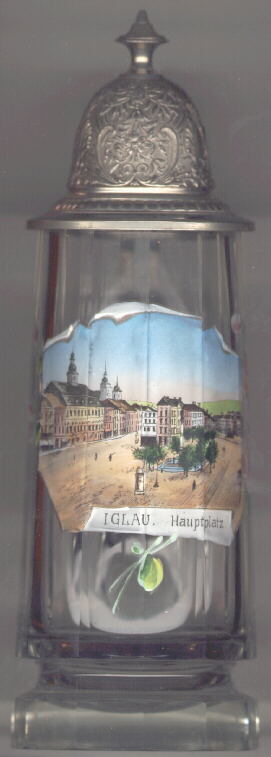 Jihlava began to develop early as a mining town. According to the legend, silver was mined as early as 799 AD.
Under the reign of King Otakar I Přemysl (1198–1230) a mining-office and a mint were established here.
Soon the town obtained many privileges, which in 1250 were confirmed by King Wenceslaus I of Bohemia.
The municipal hall contains a collection of municipal and mining laws dating as far back as 1389.
During the Hussite Wars, Jihlava stayed a Catholic stronghold and managed to resist in sieges.
On the 5th of July 1436 a treaty here whereby the Hussites acknowledged Emperor Sigismund of the
Luxembourg dynasty as king of Bohemia. During the Thirty Years' War (1618–1648)
the town was conquered and occupied twice by Swedish troops.
In 1860 it became the childhood home of Austrian composer Gustav Mahler, who retained his ties to the town until
the death of both of his parents in 1889.
Prior to 1945 Jihlava (Iglau) was the centre of the the second-largest German-speaking enclave within Czechoslovakia after the
Schönhengstgau/Hřebečsko region (Zwittau/Svitavy,
Mährisch-Trübau/Moravská Třebová, Landskon/Lanškroun,
Brüsau/Březová nad Svitavou,
Hohenstadt/Zábřeh, Müglitz/Mohelnice).
A few weeks after the end of World War II, the German inhabitants of Jihlava were evicted to Austria.
Jihlava began to develop early as a mining town. According to the legend, silver was mined as early as 799 AD.
Under the reign of King Otakar I Přemysl (1198–1230) a mining-office and a mint were established here.
Soon the town obtained many privileges, which in 1250 were confirmed by King Wenceslaus I of Bohemia.
The municipal hall contains a collection of municipal and mining laws dating as far back as 1389.
During the Hussite Wars, Jihlava stayed a Catholic stronghold and managed to resist in sieges.
On the 5th of July 1436 a treaty here whereby the Hussites acknowledged Emperor Sigismund of the
Luxembourg dynasty as king of Bohemia. During the Thirty Years' War (1618–1648)
the town was conquered and occupied twice by Swedish troops.
In 1860 it became the childhood home of Austrian composer Gustav Mahler, who retained his ties to the town until
the death of both of his parents in 1889.
Prior to 1945 Jihlava (Iglau) was the centre of the the second-largest German-speaking enclave within Czechoslovakia after the
Schönhengstgau/Hřebečsko region (Zwittau/Svitavy,
Mährisch-Trübau/Moravská Třebová, Landskon/Lanškroun,
Brüsau/Březová nad Svitavou,
Hohenstadt/Zábřeh, Müglitz/Mohelnice).
A few weeks after the end of World War II, the German inhabitants of Jihlava were evicted to Austria.
The picture on glass no. 290 [left] shows a view of the
 town
town
The  Town Hall [left] as we see it today was not built as a single building.
In the late Gothic period it consisted of three separate buildings, the northermost of which had beeen used as the seat of
the municipal administration sicne 1425. During the ensuing centuries the complex was altered several times.
One of the most important historic events ever to take place within the walls of the Town Hall was a convention held in 1346
which ratified the Basel Compactata by which the moderate Hussites were taken back into the Catholic Church
and Emperor Sigismund was acknowledged by them as king of Bohemia.
A plaque on the façade, unveiled in 1991, commemorates its ceremonial declaration.
Town Hall [left] as we see it today was not built as a single building.
In the late Gothic period it consisted of three separate buildings, the northermost of which had beeen used as the seat of
the municipal administration sicne 1425. During the ensuing centuries the complex was altered several times.
One of the most important historic events ever to take place within the walls of the Town Hall was a convention held in 1346
which ratified the Basel Compactata by which the moderate Hussites were taken back into the Catholic Church
and Emperor Sigismund was acknowledged by them as king of Bohemia.
A plaque on the façade, unveiled in 1991, commemorates its ceremonial declaration.
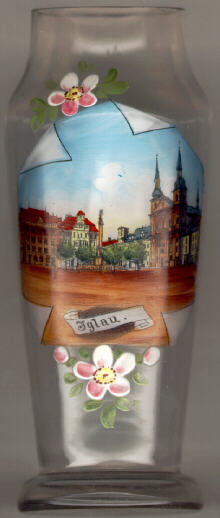
The  church of St. Ignatius of Loyola [right]
was built in 1683–1689 in typical early Baroque style by Jacopo Brascha for the Jesuit Order.
The large ceiling fresco was painted in 1717.
The pride of the church are two unique Gothic sculptures: a Pietà from the late 14th century, which is considered to be one
of the most beautiful Bohemian Madonnas, and a so-called Přemysl's Cross, a mid-14th-century sculpture of crucified
Jesus.
church of St. Ignatius of Loyola [right]
was built in 1683–1689 in typical early Baroque style by Jacopo Brascha for the Jesuit Order.
The large ceiling fresco was painted in 1717.
The pride of the church are two unique Gothic sculptures: a Pietà from the late 14th century, which is considered to be one
of the most beautiful Bohemian Madonnas, and a so-called Přemysl's Cross, a mid-14th-century sculpture of crucified
Jesus.
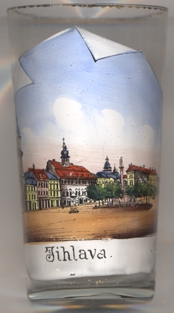 The
The  Plague Column [centre]
was erected in 1690 as an expression of gratitude that the town was spared by the Plague.
Plague Column [centre]
was erected in 1690 as an expression of gratitude that the town was spared by the Plague.
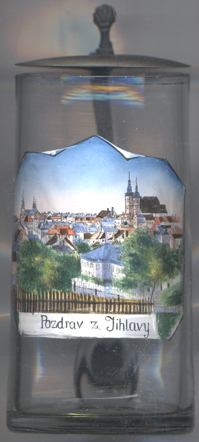
The  church of St. James the Elder [left, no. 3495: background right]
was built in Gothic style before the middle of the 13th century at the time of the establishment of the Royal Upper Town
of Jihlava. It replaced the original, Romanesque, basilica which had been destroyed by fire before it had been completed.
Te church was dedicated to St. Jacob the Elder in 1257. At the beginning of the 14th century a northern tower of
63 meters high was built, which now serves as a viewing tower and opens a view of the city and surroundings.
The southern tower, a bell-tower, was adde in the 1930s. In 1987, the interior of the church was modified when the
Art Nouveau decorations were removed. In 2008 the church was declared a national monument.
church of St. James the Elder [left, no. 3495: background right]
was built in Gothic style before the middle of the 13th century at the time of the establishment of the Royal Upper Town
of Jihlava. It replaced the original, Romanesque, basilica which had been destroyed by fire before it had been completed.
Te church was dedicated to St. Jacob the Elder in 1257. At the beginning of the 14th century a northern tower of
63 meters high was built, which now serves as a viewing tower and opens a view of the city and surroundings.
The southern tower, a bell-tower, was adde in the 1930s. In 1987, the interior of the church was modified when the
Art Nouveau decorations were removed. In 2008 the church was declared a national monument.
[https://cs.wikipedia.org/wiki/Kostel_svatého_Jakuba_Staršího_(Jihlava)]
![[scale]](lineal.jpg)